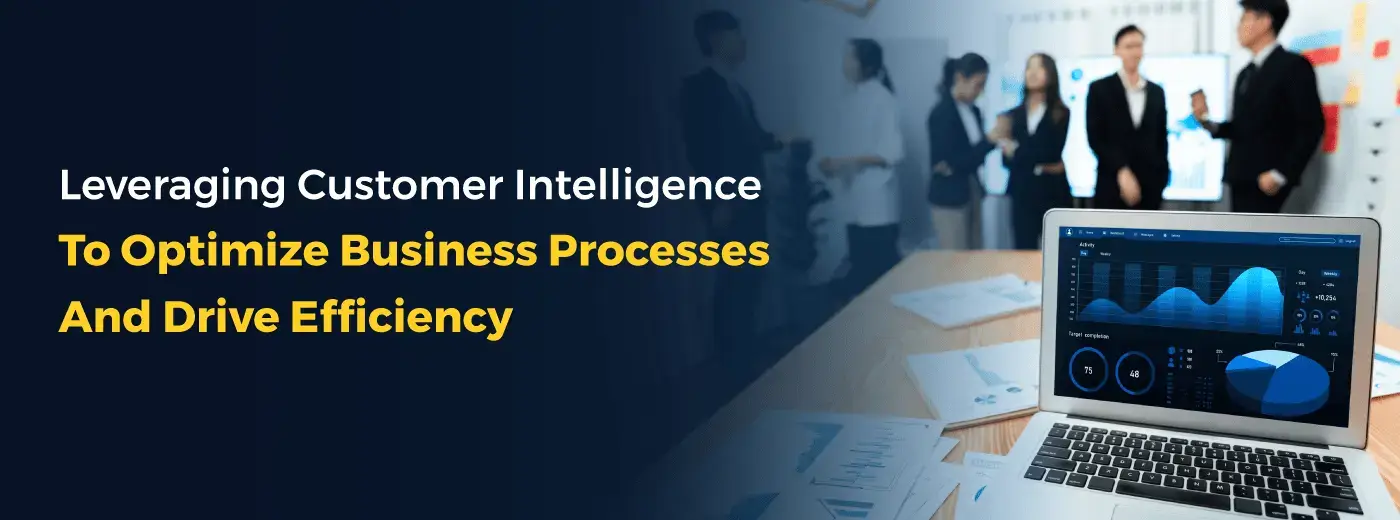
Sign up to receive latest insights & updates in technology, AI & data analytics, data science, & innovations from Polestar Analytics.
Editor's note- This blog sheds light on the untapped potential of customer intelligence in optimizing business processes and improving overall efficiency. Know how businesses can leverage customer data to gain valuable insights into customer preferences, behaviors, and needs, and use that information to optimize their operations. It also emphasizes the significance of aligning customer intelligence initiatives with business objectives and strategies and underscores the need for businesses to prioritize their customer intelligence efforts.
It's a paradox of the information age. The glut of information that bombards us daily too frequently obscures true insight. Intelligence should drive better innovation, but unless it is strategically collected and used, it functions like a summer beach novel — an engaging distraction. In the current scenario, companies increasingly use detailed analytics to fine-tune pricing, packaging, and product performance to find the next big idea.
Presently businesses have access to an unprecedented amount of customer data, but in most cases, they need assistance in figuring out what to do with it. This data deluge has created more bottlenecks for companies because they still operate with legacy systems, making it cumbersome to achieve their data integration, standardization, and quality goals. Poor data quality is another issue that regularly hampers efforts to create a granular customer view. With accurate and reliable data, the steps to create a single customer view are well-spent.
So, for that, customer experience teams need to align with data owners across the organization to understand better the data collection process and how it can be improved to reduce or eliminate the chances of human error. Data also becomes redundant quickly. Monitoring the data sources over time is significant to ensure the data quality stays the same.
The Global Customer Intelligence Platform Market size is expected to reach $8.3 billion by 2028, rising at a market growth of 28.1% CAGR during the forecast period.
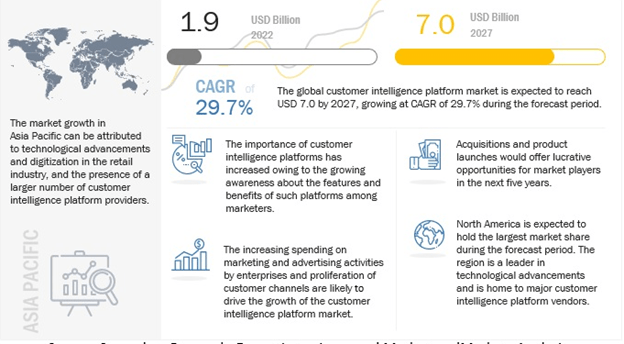
Modern businesses operate on a data-driven approach to develop relatable market products. Unlike traditional hit-and-trial methods, current organizations leverage data to make informed decisions that are highly likely to succeed. Companies collect data related to their customers using various channels such as surveys, tracking purchase journeys, recording complaints, etc. Afterward, teams use multiple techniques to search for patterns in the vast sea of collected data and provide reports to the management. One such process is called Customer Intelligence Analytics.
Customer intelligence (CI) is collecting customer data and pulling insights from it. CI allows companies to figure out who their customers are—where they live, what products they like, what problems they want to solve, and so on. The goal is to use the information to tailor each interaction to individual customers and improve their experience. Have a look at its components in the below figure.
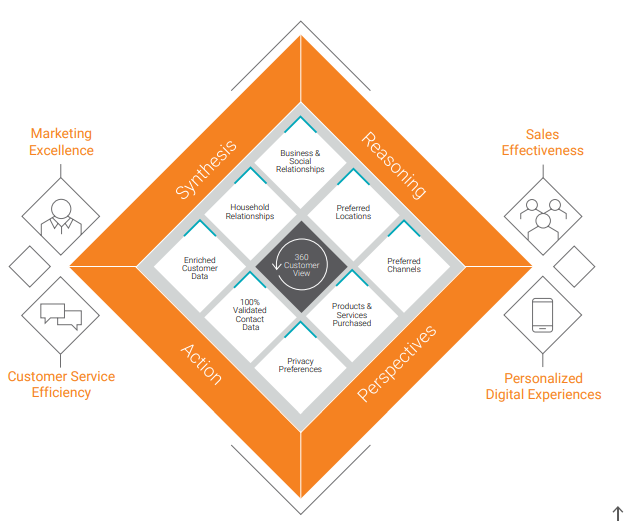
As business needs evolve and customer programs mature, the demands on existing solutions will continue to increase, and executive sponsorship becomes even more essential in the drive to modernize. But modernization only sometimes means replacing existing technology.
| For many organizations, the wisest approach is to build on what is available today and move toward flexible architectures that support tomorrow’s workloads. This approach allows leaders to augment or offload capabilities to solutions aimed at managing data and adding intelligence. |
Data and technology continue to change to address new and different use cases, and each iteration happens a little faster. To support customer questions with more and various types of answers, there is a current and potential future need for legacy applications that focus on data storage, relational applications that can support a range of resources, and future-state architectures.
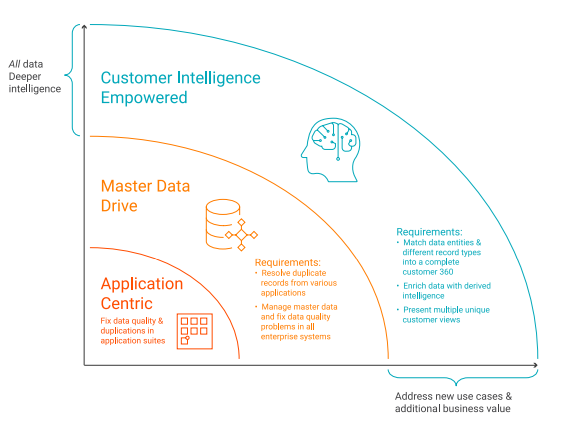
Evolving needs around customer intelligence platforms require expanded features that support complex analysis by a wide range of users. It also requires growing technology capabilities to have the horsepower and functionality to meet these demands.
The CDO can then augment internal applications by seamlessly delivering new capabilities with enhanced, intelligent data back to existing systems, including:
Master Data Management (MDM) – Designed to master core (structured data) attributes and domains for operational and analytical use. Customer insight solutions can augment and enhance data from existing MDM solutions to address new data types and business requirements, rounding out the customer profile.
Enterprise Data Warehouses (EDW) – Designed to support operational reporting and business intelligence. Data warehouses are often offloaded in support of advanced customer intelligence use cases.
Customer Relationship Management (CRM) – Designed around automating customer-facing processes for known customer and prospect information. CRM is typically augmented with additional data filtered from customer insights to focus teams on the most productive activities.
Today MDM, EDWs, and CRM may exclude critical information such as social, email, click stream, chat, analytics, and survey data. The graphic below shows how customer intelligence technology can add and infer additional data elements to the customer profile, such as relationships, sentiment, and leading indicators— rounding out the view for addressing new use cases around personalization, customer experience, next best experience, next best interaction, and customer journey.
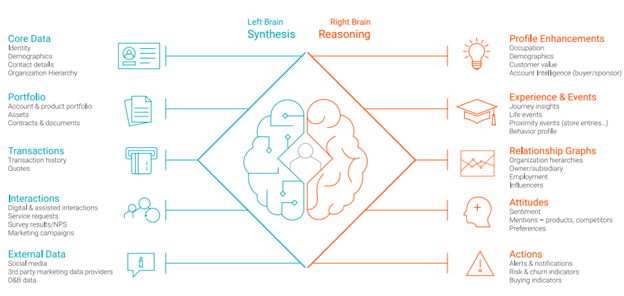
Customer Intelligence can create flexible technology platforms that enable organizations to apply data analytics and machine learning opportunities and:
Expand cross-selling and upselling: Companies can forecast campaign effectiveness and fine-tune channel marketing by analyzing customers' propensity for new offerings. This work is performed autonomously, relying on machine learning model improvement. Benefits include better campaign sales rates, lower marketing costs, and greater visibility into marketing ROI.
Channel analytics: Applying analytics to consumer behavior by channel and by an agent, organizations can optimize how they serve customers and measure ROI. This helps increase revenues, adapt and enhance services, increase satisfaction, and improve agent effectiveness.
Qualifying leads from third parties: Refine how to qualify leads from campaigns and 3rd party data can accelerate customer satisfaction and marketing resource effectiveness.
Mitigate customer attrition: Identifying at-risk consumers and the drivers of attrition. Automated monitoring of at-risk consumers offers insights that suggest preemptive actions.
Re-imagine brand loyalty: With in-depth data on customer behavior, companies can personally reward and acknowledge each consumer at all touchpoints of consumption to build connection and brand love.
We help you adopt customer intelligence practices to make informed decisions based on actionable insights derived from customer data, leading to better performance and results.
Talk to our Data Analytics ExpertsCustomer Intelligence finds applications in the following four use cases:
Behavioral Segmentation: The most popular application of Customer Intelligence, Behavioural Segmentation, classifies users into separate clusters based on behavioral patterns. Factors like being in the same purchase lifecycle stage, similarity among previous purchases, etc., dictates this classification.
Modeling User Flows: User Flow refers to a consumer's path while performing a task on your website or mobile application. Customer intelligence empowers you to monitor consumer journeys and identify the bottlenecks users face in their tasks. This will allow you to simplify your in-app features so that your customers can avail of your services hassle-free.
Geo-targeting: Geo-targeting using Customer Intelligence simplifies the process of customizing messages and offers for customers. A famous example of this application is the current online food delivery systems. They rely on Customer Intelligence data to offer popular restaurants near users' locations based on their demographic data.
Personalized Emails: Based on behavioral segments, businesses can send specific messages or offers customized to these customer segments' general preferences or buying patterns. Personalized emails are also a use case of account-based marketing (ABM) in B2B.
Step 1: Collecting Customer Data Across Channels
The first step in Customer Intelligence is the data-gathering process. This requires you to collect raw data from many channels, including emails, feedback, websites, calls, and social media platforms. This massive set of input data can be better understood by classifying it into the following three types:
Direct Feedback: This includes surveys, questionnaires, complaints, and other means of data collection in which the users willingly submit feedback about their experience with your company. Analysis of this data can provide little insight but is still essential to get a clear idea of the issues and expectations of your customers. Alternatively, customers can also offer their direct feedback to a third party that can share its results with your Business Teams.
Indirect Feedback: This data is present in social media platforms or customer service complaints where users reveal their thoughts regarding your company.
Inferred Feedback: Inferred Feedback consists of data collected using Process Mining, cookies, purchase history, and other such mediums from all enterprise processes associated with customers.
Step 2: Setup Analytics Infrastructure
Once you have assembled the required information in Step 1, it's time to implement analytics on your Customer Data. Your Engineering Team needs to either build an analysis setup from scratch or use online platforms to extract valuable insights from the raw data. Using the results of your analysis, divide your customers into various segments depending on their behavioral patterns. This will allow you to analyze each component thoroughly and gather more detailed insights.
Step 3: Turn your data into Actionable Insights
The last step of the Customer Intelligence process involves taking action on the insights extracted in step 2. Dashboards, Customer Journey Maps, Reports, etc., are some formats in which you can present insights to your teams. This will allow your Marketing Team to cater to different segments separately and create more personalized ad campaigns.
With our Analytics consulting approach start building your customer intelligence strategies to drive better decision-making and customer-centric initiatives.
Adopting technologies to improve customer experiences is critical to making more profits and customer retention. If the company wants to stand out, it should use customer intelligence seriously to make informed, data-driven decisions.
The insights the organization will get from customer intelligence will increase brand loyalty and prepare the business to face any change in the industry. Get in touch with us at Polestar Analytics today!
About Author

Content Architect
The goal is to turn data into information, and information into insights.